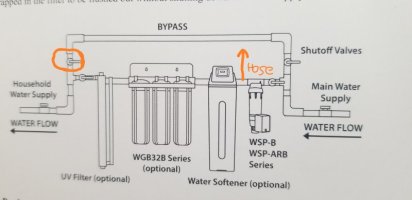I'm going to be installing a softener and filters for my well water. I have a spin down filter for course sediment and a multi-stage sediment filter for smaller sediment. What I have is more or less what is depicted in the attached picture (came with the spin down filter). I don't have a UV light. I have a few questions about how to set this up vs the diagram.
First, the bypass has two shutoff valves but many of the configurations I've seen have only one. What is the benefit to having a second valve on the bypass?
Second, I want to run a line to my hose bibs before the softener but I'd like it to pass through the spin down filter so any course sediment is removed (I sometimes see what looks like rust particles and fine sand). I'm assuming this is ok? Is there a need to install a shut off valve on this line?
Lastly, I don't understand why the multi-stage filter in this diagram is after the softener. Wouldn't it be best to install it before the softener?
First, the bypass has two shutoff valves but many of the configurations I've seen have only one. What is the benefit to having a second valve on the bypass?
Second, I want to run a line to my hose bibs before the softener but I'd like it to pass through the spin down filter so any course sediment is removed (I sometimes see what looks like rust particles and fine sand). I'm assuming this is ok? Is there a need to install a shut off valve on this line?
Lastly, I don't understand why the multi-stage filter in this diagram is after the softener. Wouldn't it be best to install it before the softener?

